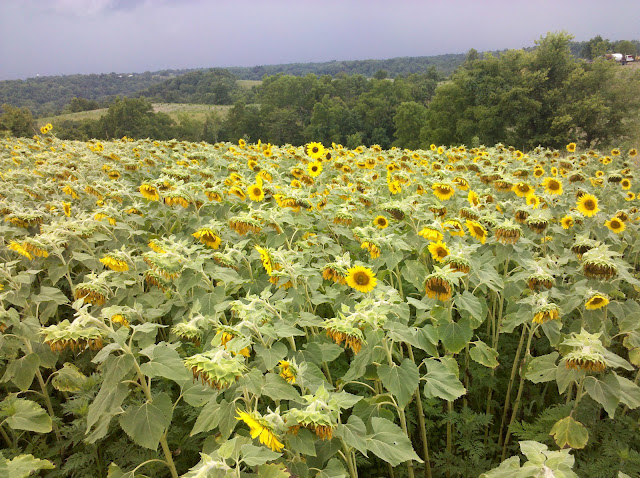While I was mowing I noticed lots of sericea lespedeza sprouting up in the areas where the fescue had been killed off. Sericea is an invasive that has little or no food value for critters and spreads like wildfire. I've already sprayed once, but it looks like this week I'll need to spray some more. I'm afraid that suppressing the Sericea is likely to be a lifetime project.
On Thursday of last week a severe thunderstorm hit the farm, dumping more than an inch of rain in a little more than an hour's time. I was grateful for the rain but discovered that the storm had done some moderate damage to the sunflowers, bending them over in patches throughout the field, like this:
The rain we received has everything looking good, and there are many doves in the field already, eating the seeds from the plants that had been blown down. I'm a bit worried that the flowers are ahead of schedule--I want them to mature in mid-August and some may be mature by August 1--and things are still pretty dry at Chaplin Bend with little rain in the forecast, but I'm still hoping for a great crop in a few weeks.
Things are not so rosy in the smaller plot where I planted the millet/milo/corn mixture. Evidently one or more of my neighbor's cows got through the fence and decided to make a meal of my grains. They are pretty much totally destroyed, grazed off a few inches above the ground:

After discovering this I repaired the one opening I knew of in the fence that divides my farm from my neighbor's (nothing like shutting the barn door after the horse--or in this case, cow--has gotten out). I hope not to see any more cows on Chaplin Bend for a while. And maybe some of the grain will still produce some seed.
The rain was also good for the corn. It appears to me that some areas will yield well (assuming a little more rain) while others will produce little or nothing, but there is no doubt that my crop is doing much better than that of most others in my area. I am very thankful.
On Thursday of last week a severe thunderstorm hit the farm, dumping more than an inch of rain in a little more than an hour's time. I was grateful for the rain but discovered that the storm had done some moderate damage to the sunflowers, bending them over in patches throughout the field, like this:
At first I thought it the damage was caused by deer or by a cow (more on that below) but the flowers on the broken stems are all intact--the stems are just broken off--and the damage is just not at the edges of the field but in patches throughout. Likely the wind just pushed some of the flowers to the breaking point. Even with the damage, though, the field is doing great, with the earliest flowers now moving toward maturity and later bloomers still in full florescence.
Things are not so rosy in the smaller plot where I planted the millet/milo/corn mixture. Evidently one or more of my neighbor's cows got through the fence and decided to make a meal of my grains. They are pretty much totally destroyed, grazed off a few inches above the ground:
How do I know it was a cow? The evidence:

After discovering this I repaired the one opening I knew of in the fence that divides my farm from my neighbor's (nothing like shutting the barn door after the horse--or in this case, cow--has gotten out). I hope not to see any more cows on Chaplin Bend for a while. And maybe some of the grain will still produce some seed.
The rain was also good for the corn. It appears to me that some areas will yield well (assuming a little more rain) while others will produce little or nothing, but there is no doubt that my crop is doing much better than that of most others in my area. I am very thankful.





No comments:
Post a Comment